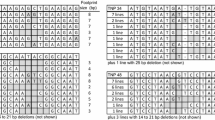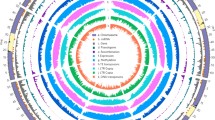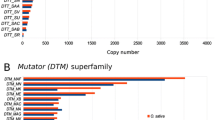Abstract
Transposon tagging is a useful tool for biological studies. Transposon insertions have been used to obtain new mutants which are extremely helpful in understanding gene function. These insertions immediately provide a means to isolate the corresponding genes. Transposon tagging has also been used to clone genes previously defined by point mutations. In addition, transposon insertions into cloned genes that lack mutations can be generated to facilitate functional analysis. The maize Ac/Ds transposon elements are known to transpose to local sites with high frequencies and have been shown to function in several dicots. To generate a collection of Ds elements for the purpose of targeted insertional mutagenesis of mapped genes in Arabidopsis, we have mapped 44 Ds insertions by simple sequence length polymorphism (SSLP). Because the Arabidopsis genome project is advancing rapidly, many genes will be discovered whose functions are unknown. The mapped 44 Ds insertions will be a useful resource for post-genome analysis of gene functions in Arabidopsis.
Similar content being viewed by others
References
Bancroft I and Dean C (1993) Transposition pattern of the maize element Ds in Arabidopsis thaliana. Genetics 134: 1221–1229.
Bell CJ and Ecker JR (1994) Assignment of 30 microsatellite loci to the linkage map of Arabidopsis. Genomics 19: 137–144.
Chang C, Bowman JL, DeJohn AW, Lander ES and Meyerowitz EM (1988) Restriction fragment length polymorphism linkage map for Arabidopsis thaliana. Proc Natl Acad Sci USA 85: 6856–6860.
Dellaert LMW, van Es JYP and Koornneef M (1979) Eceriferum mutants in Arabidopsis thaliana (L.) Heynh: II. Phenotypic and genetic analysis. Arabid Inf Serv 16: 10–26.
Estelle MA and Somerville CR (1987) Auxin-resistant mutants of Arabidopsis thaliana with an altered morphology. Mol Gen Genet 206: 200–206.
Estelle MA and Somerville CR (1989) The mutants of Arabidopsis. Trands Genet 2: 89–93.
Feldmann KA (1991). T-DNA insertion mutagenesis in Arabidopsis: mutational spectrum. Plant J 1: 71–82.
Feldmann KA, Marks MD, Christianson ML and Quatrano S (1989). A dwarf mutant of Arabidopsis generated by T-DNA insertion mutagenesis. Science 243: 1351–1354.
Honma MA, Baker BJ and Waddell CS (1993) High-frequency germinal transposition of DsALS in Arabidopsis. Proc Natl Acad Sci USA 90: 6242–6246.
Kempin SA, Liljegren SJ, Block LM, Rounsley SD, Yanofsky MF and Lam E (1997) Inactivation of the Arabidopsis AGL5 MADS-box gene by homologous recombination. Nature 389: 802–803.
Klimyuk VI, Carrol BJ, Thomas CM and Tones JDG (1993) Alkali treatment for rapid preparation of plant material for reliable PCR analysis. Plant J 3: 493–494.
Konieczny A and Ausubel FM (1993) A procedure for mapping Arabidopsis mutations using co-dominant ecotype-specific PCR-based markers. Plant J 4: 403–410.
Koornneef M and Hanhart CJ (1983) Linkage marker stocks of Arabidopsis thaliana, Arabid Inf Serv 20: 89–92.
Koornneef M, van Eden J, Hanhart CJ, Stam P, Braaksma FJ and Feenstra WJ (1983) Linkage map of Arabidopsis thaliana. J Hered 74: 265–272.
Lister C and Dean C (1993) Recombination inbred lines for mapping RFLP and phenotypic markers in Arabidopsis thaliana. Plant J 4: 745–750.
Litt M and Luty JA (1989). A hypervariable microsatellite revealed by in vitro amplification of a dinuclecotide repeat within the cardiac muscle action gene. Am J Hum Genet 44: 397–401.
Ma H, Yanofsky MF and Meyerowitz EM (1990) Molecular cloning and characterization of GPA1, a G protein subunit gene from Arabidopsis thaliana. Proc Natl Acad Sci USA 87: 3821–3825.
Meyerowitz EM and Pruitt RE (1985) Arabidopsis thaliana and plant molecular Genetics. Science 229: 1214–1218.
Miao ZH and Lam E (1995) Target disruption of the TGA3 locus in Arabidopsis thaliana. Plant J 7: 359–365.
Napoli C, Lemieux C and Jorgensen R. (1990) Introduction of chimeric chalcone synthase gene into petunia results in reversible co-suppression of homologous genes in trans. Plant Cell 2: 279–289.
Smith CJS, Watson CF, Ray J, Bird CR, Morris PC, Schuch W and Grierson D. (1988) Antisense RNA inhibition of polyalacturonase gene expression in transgenic tomatoes. Nature 334: 724–726.
Sundaresan V, Springer P, Volpe T, Haward S, Jones JD, Dean C, Ma H and Martienssen R. (1995) Patterns of gene action in plant development revealed by enhancer trap and gene trap transposable elements. Genes Devel 9: 1797–1810.
Tautz D (1989) Hypervariability of simple sequences as a general source for polymorphic DNA markers. Nucleic Acid Res 17: 6463–6471.
Weber JL and May PE (1989) Abundant class of human DNA polymorphisms which can be typed using the polymerase chain reaction. Am J Hum Genet 44: 388–396.
Author information
Authors and Affiliations
Rights and permissions
About this article
Cite this article
Li, F., Flanagan, C.A., Zhao, Y. et al. Assignment of 44 Ds Insertions to the Linkage Map of Arabidopsis. Plant Molecular Biology Reporter 17, 109–122 (1999). https://doi.org/10.1023/A:1007549429131
Issue Date:
DOI: https://doi.org/10.1023/A:1007549429131




